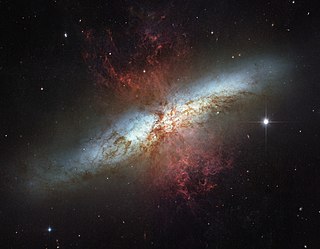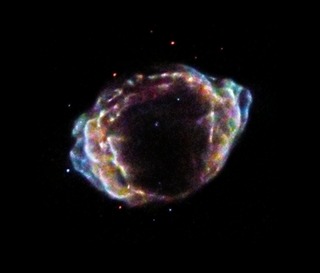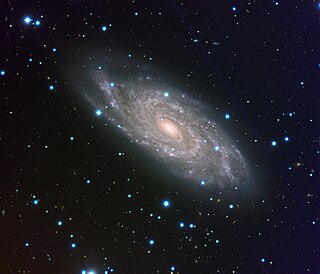
The Crab Nebula is a supernova remnant and pulsar wind nebula in the constellation of Taurus. The common name comes from William Parsons, 3rd Earl of Rosse, who observed the object in 1842 using a 36-inch (91 cm) telescope and produced a drawing that looked somewhat like a crab. The nebula was discovered by English astronomer John Bevis in 1731, and it corresponds with a bright supernova recorded by Chinese astronomers in 1054. The nebula was the first astronomical object identified that corresponds with a historically-observed supernova explosion.

A magnetar is a type of neutron star with an extremely powerful magnetic field (∼109 to 1011 T, ∼1013 to 1015 G). The magnetic-field decay powers the emission of high-energy electromagnetic radiation, particularly X-rays and gamma rays.

The Chandra X-ray Observatory (CXO), previously known as the Advanced X-ray Astrophysics Facility (AXAF), is a Flagship-class space telescope launched aboard the Space ShuttleColumbia during STS-93 by NASA on July 23, 1999. Chandra is sensitive to X-ray sources 100 times fainter than any previous X-ray telescope, enabled by the high angular resolution of its mirrors. Since the Earth's atmosphere absorbs the vast majority of X-rays, they are not detectable from Earth-based telescopes; therefore space-based telescopes are required to make these observations. Chandra is an Earth satellite in a 64-hour orbit, and its mission is ongoing as of 2023.

Messier 82 (also known as NGC 3034, Cigar Galaxy or M82) is a starburst galaxy approximately 12 million light-years away in the constellation Ursa Major. It is the second-largest member of the M81 Group, with the D25 isophotal diameter of 12.52 kiloparsecs (40,800 light-years). It is about five times more luminous than the Milky Way and its central region is about one hundred times more luminous. The starburst activity is thought to have been triggered by interaction with neighboring galaxy M81. As one of the closest starburst galaxies to Earth, M82 is the prototypical example of this galaxy type. SN 2014J, a type Ia supernova, was discovered in the galaxy on 21 January 2014. In 2014, in studying M82, scientists discovered the brightest pulsar yet known, designated M82 X-2.

NGC 6946, sometimes referred to as the Fireworks Galaxy, is a face-on intermediate spiral galaxy with a small bright nucleus, whose location in the sky straddles the boundary between the northern constellations of Cepheus and Cygnus. Its distance from Earth is about 25.2 million light-years or 7.72 megaparsecs, similar to the distance of M101 in the constellation Ursa Major. Both were once considered to be part of the Local Group, but are now known to be among the dozen bright spiral galaxies near the Milky Way but beyond the confines of the Local Group. NGC 6946 lies within the Virgo Supercluster.

Cassiopeia A (Cas A) is a supernova remnant (SNR) in the constellation Cassiopeia and the brightest extrasolar radio source in the sky at frequencies above 1 GHz. The supernova occurred approximately 11,000 light-years (3.4 kpc) away within the Milky Way; given the width of the Orion Arm, it lies in the next-nearest arm outwards, the Perseus Arm, about 30 degrees from the Galactic anticenter. The expanding cloud of material left over from the supernova now appears approximately 10 light-years (3 pc) across from Earth's perspective. It has been seen in wavelengths of visible light with amateur telescopes down to 234 mm (9.25 in) with filters.
The SuperNova Early Warning System (SNEWS) is a network of neutrino detectors designed to give early warning to astronomers in the event of a supernova in the Milky Way, our home galaxy, or in a nearby galaxy such as the Large Magellanic Cloud or the Canis Major Dwarf Galaxy.

NGC 1309 is a spiral galaxy located approximately 120 million light-years away, appearing in the constellation Eridanus. It is about 75,000 light-years across, and is about 3/4s the width of the Milky Way. Its shape is classified as SA(s)bc, meaning that it has moderately wound spiral arms and no ring. Bright blue areas of star formation can be seen in the spiral arms, while the yellowish central nucleus contains older-population stars. NGC 1309 is one of over 200 members of the Eridanus Group of galaxies.

IC 443 is a galactic supernova remnant (SNR) in the constellation Gemini. On the plane of the sky, it is located near the star Eta Geminorum. Its distance is roughly 5,000 light years from Earth.

The known history of supernova observation goes back to 1006 CE. All earlier proposals for supernova observations are speculations with many alternatives.

SN 1979C was a supernova about 50 million light-years away in Messier 100, a spiral galaxy in the constellation Coma Berenices. The Type II supernova was discovered April 19, 1979 by Gus Johnson, a school teacher and amateur astronomer. This type of supernova is known as a core collapse and is the result of the internal collapse and violent explosion of a large star. A star must have at least 9 times the mass of the Sun in order to undergo this type of collapse. The star that resulted in this supernova was estimated to be in the range of 20 solar masses.

G1.9+0.3 is a supernova remnant (SNR) in the constellation of Sagittarius. It is the youngest-known SNR in the Milky Way, resulting from an explosion the light from which would have reached Earth some time between 1890 and 1908. The explosion was not seen from Earth as it was obscured by the dense gas and dust of the Galactic Center, where it occurred. The remnant's young age was established by combining data from NASA's Chandra X-ray Observatory and the VLA radio observatory. It was a type Ia supernova. The remnant has a radius of over 1.3 light-years.

SCP 06F6 is an astronomical object of unknown type, discovered on 21 February 2006 in the constellation Boötes during a survey of galaxy cluster CL 1432.5+3332.8 with the Hubble Space Telescope's Advanced Camera for Surveys Wide Field Channel.

NGC 6118 is a grand design spiral galaxy located 83 million light-years away in the constellation Serpens. It measures roughly 110,000 light-years across; about the same as our own galaxy, the Milky Way. Its shape is classified as "SA(s)cd," meaning that it is unbarred and has several rather loosely wound spiral arms. The large numbers of bright bluish knots are active star-forming regions where some very luminous and young stars can be perceived.

Sagittarius A is a complex radio source at the center of the Milky Way, which contains a supermassive black hole. It is located in the constellation Sagittarius, and is hidden from view at optical wavelengths by large clouds of cosmic dust in the spiral arms of the Milky Way. The dust lane that obscures the Galactic Center from a vantage point around the Sun causes the Great Rift through the bright bulge of the galaxy.

Gamma-ray astronomy is the astronomical observation of gamma rays, the most energetic form of electromagnetic radiation, with photon energies above 100 keV. Radiation below 100 keV is classified as X-rays and is the subject of X-ray astronomy.

Astrophysical X-ray sources are astronomical objects with physical properties which result in the emission of X-rays.

Patrizia Caraveo is an Italian astrophysicist.

ASASSN-15lh is an extremely luminous astronomical transient event discovered by the All Sky Automated Survey for SuperNovae (ASAS-SN), with the appearance of a superluminous supernova event. It was first detected on June 14, 2015, located within a faint galaxy in the southern constellation Indus, and was the most luminous supernova-like object ever observed. At its peak, ASASSN-15lh was 570 billion times brighter than the Sun, and 20 times brighter than the combined light emitted by the Milky Way Galaxy. The emitted energy was exceeded by PS1-10adi.

Apep is a triple star system containing a Wolf–Rayet binary and a hot supergiant, located in the constellation of Norma. Named after the serpent deity from Egyptian mythology, the star system is surrounded by a vast complex of stellar wind and cosmic dust thrown into space by the high rotation speed of the binary's primary star and formed into a "pinwheel" shape by the secondary star's influence. Ground-based studies of the system in the 2010s concluded that the system was the best known gamma-ray burst progenitor candidate in the Milky Way galaxy.


















